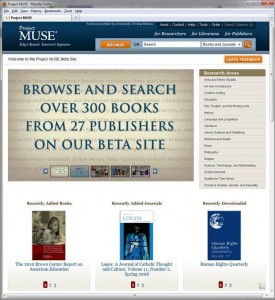Ebooks in K12
Posted: June 5, 2012 | Author: Steven Harris | Filed under: Collection Philosophy, E-books, Professional development | Leave a comment »Here is an interesting workshop for those in K-12 being offered by ALA Techsource:
“Choosing an E-Book Platform that Works for Your K12 Library”
being lead by Buffy J. Hamilton
August 8
http://www.alastore.ala.org/detail.aspx?ID=3832&zbrandid=4634
Acquiring E-Books
Posted: February 9, 2012 | Author: Steven Harris | Filed under: E-books | 7 Comments »So you want to acquire some e-books for your library? Overdrive isn’t the only game in town. There is a huge and growing number of ways for libraries to acquire e-books. I thought I’d compile a list. The main pathways I see (although the boundaries between them are by no means solid) are aggregators, vendors, and publishers. This list is far from complete. My knowledge is primarily in the North American academic library arena. If you have information to add, post a comment.
Aggregators:
Aggregators gather titles from a variety of publishers and present them on a single platform. Titles can typically be licensed on a rental or purchase model and are available in subject packages or on a title-by-title basis. The delivery platforms vary as to their features and functions.
ACLS Humanities E-Book:
http://www.humanitiesebook.org
The American Council of Learned Societies. Primarily a subscription service. Files: page image, PDF, txt.
Books24x7:
http://www.books24x7.com
Business, finance, and IT focused collections. Files: HTML (all web-based platform).
Credo Reference:
http://www.credoreference.com
Over 500 reference books. Files: HTML (all web-based platform).
Dawson Era:
http://www.dawsonera.com
From British bookseller Dawson Books. Don’t know much about them.
Digitalia:
http://www.digitaliapublishing.com
Aggregator of Spanish-language e-books from Spain, Caribbean, and Latin America. Variety of purchase and lease plans, including subject collections. Files: PDF, HTML.
EBL:
http://www.eblib.com
Australian company (but widely available). Multi-publisher, multi-subject collections. Strong on academic material. Variety of purchase options, including user driven. EBL was an early developer of the “short-term loan†for e-books. Files: PDF, EPUB, multiple concurrent users, and downloadable. Download requires Adobe Digital Editions.
Ebrary (Proquest):
http://www.ebrary.com
Wide variety of publishers with materials for academic, public, and school libraries (although academic is the main strength). Variety of use options, including user driven and short-term loan. Â Variety of use options, including user driven acquisitions. Files: PDF, downloadable. Download requires Adobe Digital Editions.
Ebsco:
http://www.ebscohost.com/ebooks/home
“E-book collection from Ebscohost†– includes the former NetLibrary collections. Variety of use options, including user driven and short-term loan. Files: PDF. Download requires Adobe Digital Editions.
Freading:
http://www.libraryideas.com/freading.html
Pay-per-use model from Library Ideas. Popular reading? File: EPUB?
JSTOR:
http://about.jstor.org/books
Not yet available. Will include aggregation from major university and commercial scholarly presses.
MyiLibrary (Ingram/Coutts):
http://www.myilibrary.com
Aggregation platform serving Ingram and Coutts customers (public, school, academic, and professional libraries). Variety of use options, including user driven acquisitions. Files: PDF, downloadable. Download requires Adobe Digital Editions.
NCBI:
http://www.ncbi.nlm.nih.gov/books
National Center for Biotechnology Information. Primarily life science and healthcare titles, most with free download and purchase on demand. Files: HTML, selective PDF.
NetLibrary (See Ebsco)
OverDrive:
http://www.overdrive.com
Widely used in the public library world. Various purchase options available. Files: PDF, EPUB, Kindle, audio.
Ovid:
http://www.ovid.com/site/products/books_landing.jsp
Primarily science and medicine topics. Files: ?
Project MUSE:
http://muse.jhu.edu/about/UPCC.html
Platform host for the University Press E-book Consortium. Various purchase options. Content integrates in with Muse journals. Files: PDF (DRM-free).
Safari Books (direct and through Proquest):
http://safaribooksonline.com
http://www.proquest.com/en-US/catalogs/databases/detail/safari_tech_books.shtml
Direct from Safari is designed more for individuals or as an enterprise model. Through Proquest there are a variety of purchase models. Files: HTML?
3M:
http://solutions.3m.com/wps/portal/3M/en_US/3MLibrarySystems/Home/Products/Cloud+Library
A new player in the e-book market, although not new to library services. The 3m Cloud Library has a lot of unique features, link kiosks and dedicated ereaders, but not a big track record. Files: EPUB?
Torrossa
http://www.torrossa.it
Aggregator platform of bookseller Casalini Libri of Italy. Includes Italian, Portuguese, and Spanish e-books. Variety of use options. See also EIO – Editoria Italiana Online for Italian titles only. Files: ?
Vendors:
As with print books, vendors function as a mediator between the library and the publisher or aggregator. You can buy and pay for your e-books from a single source, but actually get access from multiple providers. Some vendors like Ingram/Coutts and Dawson serve as both the vendor and the aggregator.
Baker & Taylor:
http://www.baker-taylor.com/index.cfm
Dawson Books:
http://www.dawsonbooks.co.uk/services/e-books.html
Casalini Libri
http://www.casalini.it
European book vendor. See Torrossa aggregator.
Coutts (academic division Ingram):
http://www.couttsinfo.com/econtent/econtent.htm
Harrassowitz
http://www.harrassowitz.de/subscription_services/E-Resources_News_Offers.html
Ingram:
http://www.ingramcontent.com/MRKNG/2011/52432/52432Coresource.html
Swets:
http://www.swets.com/swetswise/ebooks
W.T. Cox:
http://www.wtcox.com/ebooks.html
YBP (academic division of Baker & Taylor):
http://www.ybp.com/acad/ebooks.htm
Publishers:
Many publishers offer their books through aggregators and vendors but also through their own platform or storefront. I’ve listed here mainly publishers that offer a hosted platform for libraries. A couple, like California and Michigan, are really storefronts intended for end users. Some, like Cambridge and Oxford, are actually beginning to function as aggregators of other publishers’ e-books. There are many others that I have not listed. Feel free to note those in the comments.
American Psychological Association:
http://www.apa.org/pubs/marketing/green.aspx
Cambridge University Press:
http://ebooks.cambridge.org
De Gruyter:
http://www.degruyter.com/dg/page/38/ebooks
Gale:
http://www.gale.cengage.com/gvrl/
Elsevier:
http://www.elsevier.com/wps/find/books_browse.cws_home
McGraw-Hill:
http://www.mhebooklibrary.com/bookshelf
MIT Press:
http://mitpress-ebooks.mit.edu
Morgan & Claypool Publishers:
http://www.morganclaypool.com
National Academies Press:
http://www.nap.edu
Oxford University Press:
http://www.oxfordscholarship.com
http://www.oxfordreference.com
Palgrave Macmillan:
http://www.palgrave.com/ebooks/vendors.asp
Sage Publishing (primarily offered through aggregators):
http://www.uk.sagepub.com/ebooks.sp
Springer:
http://www.springerlink.com/books/
Taylor & Francis:
http://www.ebookstore.tandf.co.uk
University of California Press (mainly intended for individual users not libraries):
http://www.ucpress.edu/ebooks.php
University of Michigan Press (mainly intended for individual users not libraries):
http://www.press.umich.edu/ebooks/
Wiley Blackwell:
http://olabout.wiley.com/WileyCDA/Section/id-406090.html
Academic Kindle
Posted: January 23, 2012 | Author: Steven Harris | Filed under: E-books, Online collections | Tags: Amazon, Kindle, lending | 6 Comments »ALA Midwinter 2012: I don’t know if this is common knowledge, but a source at Ebsco tells me that Amazon will soon start offering Kindle downloadable content through academic e-book aggregators like Ebsco, Ebrary, and EBL. I didn’t hear a timeframe on this other than “soon.” Obviously, the Kindle program through OverDrive was considered a beta project. Amazon seems ready to expand library lending beyond the public library market.
As it was described to me, the Kindle academic lending would operate somewhat differently than the OverDrive program, which actually redirects users to affect the loan through the Amazon store. It sounds like the academic plan is to allow a seamless and direct load to the Kindle Fire. Other Kindle devices would require download to a computer and then transfer to the device. That procedure sounds a lot like Adobe DRM-protected files, where an e-book is downloaded and authorized through Adobe Digital Editions and then transferred to a registered device. One assumes that Amazon won’t using Adobe DRM. So, what is the transfer mechanism? Just a drag and drop file management process also seems unlikely. So, I don’t know how much all this is vapor ware , but my source seemed pretty confident it would hit the shelf fairly soon. Looking forward to seeing how it works out.
Books-n-Journals
Posted: August 4, 2011 | Author: Steven Harris | Filed under: E-books, Online collections | Leave a comment »Project Muse is rolling out a beta site that demonstrates their future integration of journals and ebooks. (You’ll need a campus subscription to Project Muse to get to the beta.) The ebook product should go live in January 2012. We can certainly expect the ebooks to be a quality product, like the journals. Muse is collaborating with the University Press Content Consortium to provide “digital books” from about 65 different publishers. According to Project Muse newsletter, the digital and print versions of books will be released by the publishers simultaneously. The ebooks will also offer unlimited simultaneous use and will have no DRM. The files will be PDF.
If the beta site is any indication, each book will divided up into individual PDF files for each chapter. I know the intent is to keep the file sizes manageable and to make each book consumable in smaller bites. I think this actually works in a negative way towards download of books to mobile readers. Does anyone actually want to download and manage 15 different files in order to read a single book? There should be a choice to download the entire book. In fact, I’m rather disappointed there won’t be a file option other than PDF. EPUB would work more seamlessly with mobile readers (well, Kindle excepted).
One of the points I’m interested in is whether users will really embrace a journals-n-ebooks collection mix. I know several scientific publishers have already been offering this for several years. (See Elsevier and Springer for example.) And the great push in libraryland is to develop discovery layers that integrate everything into one search interface. Still, platforms like Project Muse and JSTOR that have done such a good job with providing journal access are venturing into new territory. (JSTOR will have an ebook product available on about the same timeframe as Muse.) Platforms like this have always been a selective subset of journals. In such a selective environment, does it make sense to integrate journals and books? Of course, their users will love these platforms. The user population for Muse comes primarily from book-centric humanities disciplines. They will likely love having more content and having books added to the mix.
Welcome to the World of Tomorrow
Posted: June 3, 2011 | Author: Steven Harris | Filed under: E-books | Leave a comment »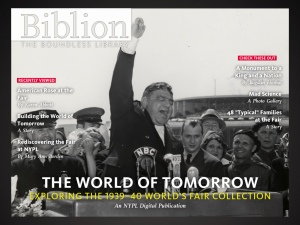 Welcome to the World of Tomorrow! That’s the kind of jingoistic positivism you’d hear about things like the World’s Fair back in the 1930s and 40s. It’s also what you’ll hear from me right now as I talk about the New York Public Library’s new iPad app, Biblion, which was just released this week. Biblion is a marvelous showcase of how to design interactive information for the touchscreen tablet. It is not a book, per se. Nor is it a website. It is an amalgam of text, image, audio, and video organized in a way that makes sense on this new platform.
Welcome to the World of Tomorrow! That’s the kind of jingoistic positivism you’d hear about things like the World’s Fair back in the 1930s and 40s. It’s also what you’ll hear from me right now as I talk about the New York Public Library’s new iPad app, Biblion, which was just released this week. Biblion is a marvelous showcase of how to design interactive information for the touchscreen tablet. It is not a book, per se. Nor is it a website. It is an amalgam of text, image, audio, and video organized in a way that makes sense on this new platform.
Biblion: The Boundless Library contains a wonderful assortment of archival materials from NYPL about the 1939-1940 World’s Fair in New York. The NYPL website suggests that this is just the first of many “displays” for Biblion. Is it a magazine? Is it an encyclopedia? A book series? We don’t know yet. They call it “An NYPL Digital Publication.” Welcome to the post-bibliographic age!
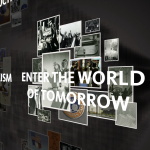 Part of the beauty of Biblion is the variety of navigation schemes that are employed. The linearity of the print book is forever destroyed in this publication.
Part of the beauty of Biblion is the variety of navigation schemes that are employed. The linearity of the print book is forever destroyed in this publication. 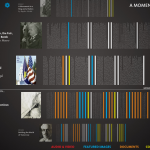 You can riffle through images, scroll through text, pinch and expand thumbnails, and follow sidebars to your heart’s content. Like the much-lauded The Elements, Biblion takes familiar kinds of information (photos, manuscript materials, drawings, posters, etc.) and reworks them for a new medium. All of these are fairly intuitive. The iconography makes it easy to work your way back to familiar territory. There are, nonetheless, a couple of missing elements that I think would be useful: an index or sitemap and a search function.
You can riffle through images, scroll through text, pinch and expand thumbnails, and follow sidebars to your heart’s content. Like the much-lauded The Elements, Biblion takes familiar kinds of information (photos, manuscript materials, drawings, posters, etc.) and reworks them for a new medium. All of these are fairly intuitive. The iconography makes it easy to work your way back to familiar territory. There are, nonetheless, a couple of missing elements that I think would be useful: an index or sitemap and a search function.
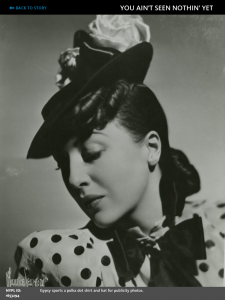 The elements of Biblion work well together. The whole is rather masterfully curated, wedding spot-on selections from an archive of over 2,500 boxes with contemporary essays by notable authors and scholars. Historic figures like Gypsy Rose Lee, Albert Einstein, and Adolf Hitler all weave together in an interesting story (that still functions as a story). Essays by Amy Azzarito, William Grimes, and Karen Abbott enrich the visual information with compelling text.
The elements of Biblion work well together. The whole is rather masterfully curated, wedding spot-on selections from an archive of over 2,500 boxes with contemporary essays by notable authors and scholars. Historic figures like Gypsy Rose Lee, Albert Einstein, and Adolf Hitler all weave together in an interesting story (that still functions as a story). Essays by Amy Azzarito, William Grimes, and Karen Abbott enrich the visual information with compelling text. 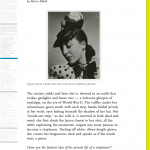
A library created this wonderful app, but it is unclear how libraries can help serve library users in this particular information ecosystem. Apple designs things to be accessed and used by individuals. Sharing is not yet part of the plan. Even in a non-sharing environment, however, libraries can still serve to aid discovery. If you’ve ever tried to find something in iTunes, you can image how useful a catalog of apps would be. In terms of owning and sharing collections, maybe those days are over. Maybe now we’ve moved into a world where we still buy materials, but we give each copy away to individuals on an “as needed” basis. Rushing headlong into the post-bibliographic world of tomorrow.
Can I download that?
Posted: April 21, 2011 | Author: Steven Harris | Filed under: E-books | Tags: Amazon, Kindle, OverDrive | Leave a comment »Reference librarians everywhere breathed a sigh of relief yesterday. OverDrive announced a relationship with Amazon to allowing download of library ebooks to Kindle devices. OverDrive is an ebook service that is popular in public libraries around the world. They have provided ebooks primarily in PDF and ePub file format with Abode digital rights management (DRM). (They also offer MP3 audiobooks.) Kindle books use Amazon’s own AZW file format and a different DRM. So downloading to a Kindle was never possible with OverDrive collections. Public service folks in libraries have probably heard a million times, “why can’t I download your ebooks to my Kindle?” Now they won’t have to answer that question anymore. It will probably take a while for the new format to show up at OverDrive. Details of the roll-out are yet to come.
Many academic libraries, however, use different ebook services than OverDrive. We’ll have to wait and see if services like ebrary, Netlibrary (soon to be called something more Ebsco-ish), EBL, or some of the publisher-specific platforms will begin to offer downloading to Kindle. I’m not holding my breath.
The news:
The same, only different!
Posted: April 5, 2011 | Author: Steven Harris | Filed under: E-books | 2 Comments » The blow up about HarperCollins and the 26-use limit for library ebooks raises a lot of interesting and contradictory issues in the library/publisher relationship typology. One of these is how, at various turns, one or the other of the parties wants ebooks to behave just like print books. Then, after a moment of arguing, the parties change sides. This begins to be a little ridiculous after a while. In an NPR story Monday (yes, the issue has risen to NPR level visibility), Eli Neiburger raises some of these points. A trendspotting symposium hosted by the Connecticut Library Consortium today also highlights the topic. There are a lot of good tweets, if you weren’t able to attend.
The blow up about HarperCollins and the 26-use limit for library ebooks raises a lot of interesting and contradictory issues in the library/publisher relationship typology. One of these is how, at various turns, one or the other of the parties wants ebooks to behave just like print books. Then, after a moment of arguing, the parties change sides. This begins to be a little ridiculous after a while. In an NPR story Monday (yes, the issue has risen to NPR level visibility), Eli Neiburger raises some of these points. A trendspotting symposium hosted by the Connecticut Library Consortium today also highlights the topic. There are a lot of good tweets, if you weren’t able to attend.
Clearly, the notion that ebooks and print books should behave the same is absurd. But both parties have a hard time giving up the idea. From a commercial perspective it is easy to see why. Print books are unique and discrete objects. Despite the bibliographic complexities of bookishness (see FRBR ideas of “work,” “expression,” “manifestation,” and “item”–PDF), a single book can be sold, owned, shelved, loaned. But it is never more than a single book. It gives comfort to the seller and the buyer. The sense of ownership is clear and the limits on duplication and distribution are obvious. All of that goes out the window with ebooks. What does an owner own? How can the imminent (and infinite) power to duplicate and disseminate be limited?
But some other aspects of bookishness begin to seem strange and inhibiting as we move into the digital realm. An idea at the heart of HarperCollins’ new ebook model is that print books wear out, and, therefore, so should ebooks. As though their business model is based on books wearing out. But more to my point here: PRINT BOOKS WEAR OUT! What an unfortunate limitation. Can’t we begin to see that one of the beauties of ebooks is that they don’t wear out? (Let’s leave aside all the questions of digital preservation. The mere act of using an ebook doesn’t contribute to its degradation.)
Another obvious limitation of print books is that a particular book has to be in one place. When we hunt for a book in the library, it can only reside in one spot. I hope I know what that spot is and understand the library’s organizational scheme. A lot of our professional literature in recent years has addressed the notion of organizational schemes and how libraries seem to make it more difficult to find something on the shelf than it ought to be. An ebook has “no shelf required.” It can be anywhere; it can be in a multitude of places. Although, British publishers encountered opposition similar to what HarperCollins has experienced, when they floated an idea several months ago that library users should be required to come into the library in order to borrow ebooks. (See the Guardian.)
But we cling to the notion that print books are comforting. We love the idea of browsing the stacks for books, although we can’t find the one we originally went in there to get. We like to “curl up” with print books. Even though ebooks in no way inhibit curling, and might, in fact, aid it. We wish ebooks could be more like print books, only different.

